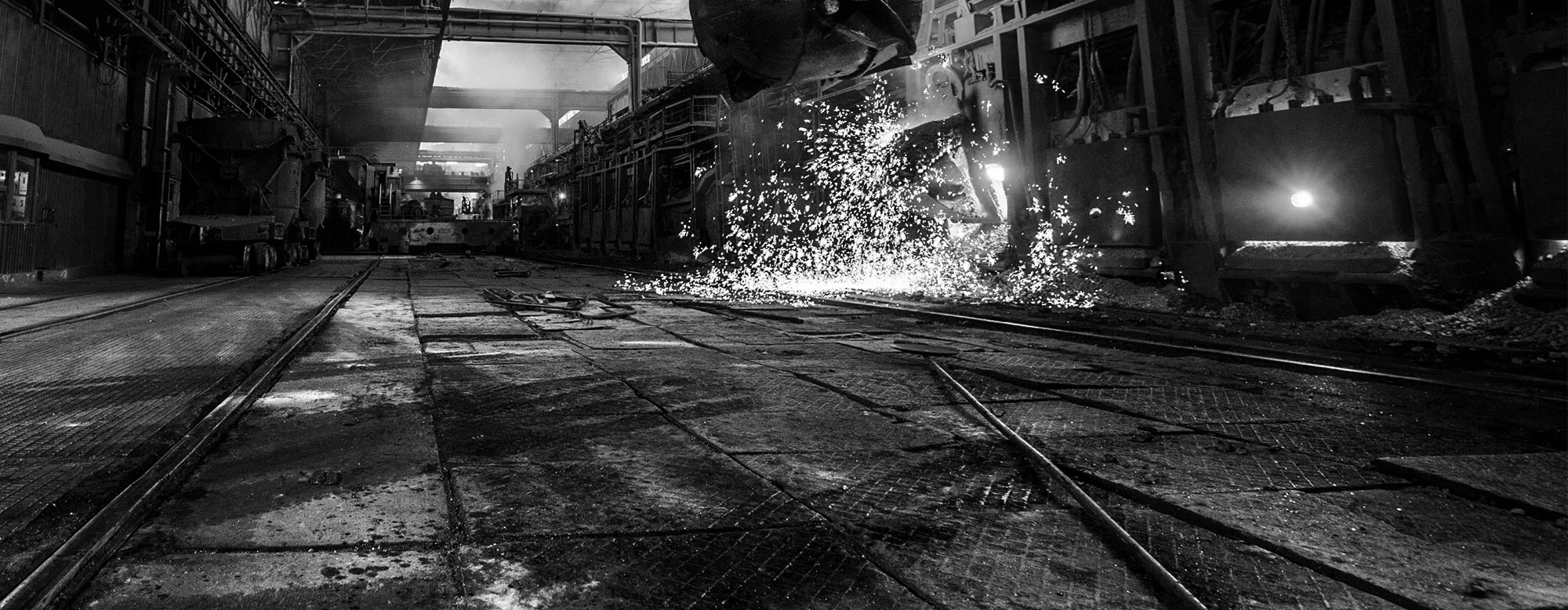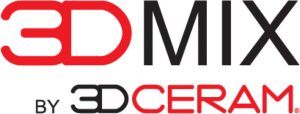Additive Manufacturing of Ceramics for Biomedical Applications
June 2, 2020 3DCeram Sinto USA

3DCERAM leverages stereolithography (SLA) 3D printing technology for more than 10 years to manufacture custom-made or small series of bone substitutes (intervertebral cages and tibial osteotomy wedges) and cranial or jawbone implants. This technology is able to produce ceramic components layer by layer using a laser which polymerizes a paste composed of photosensitive resin and ceramic. The parts are then subjected to a heat treatment (debinding followed by sintering) which eliminates the resin and densifies the ceramic.
Ceramics are a key component of the biomaterials market, a growing market due to the many properties (biodegradable, bio-inert, antibacterial effect, etc.) making ceramic materials essential
technology in the medical sector. Applied to the biomedical market, 3D printing allows the realization of bone substitutes, custom ceramic implants and surgical tools. The outstanding biocompatibility of ceramics, extremely regular porous structure and mechanical strength are the main qualities of these 3D bioceramics. A study from Smithers Rapra forecasts the rapid growth off 3D printed medical and pharmaceutical products over the next 10 years, from $400 million as of 2016 to a $6 billion market by 2027.
The main benefits of additive manufacturing for orthopaedics is the bone integration capability. It also enables the manufacture of complex parts, simultaneously and for different sizes, shapes, and designs.
Additive manufacturing brings a new dimension to the standard biomedical process. Several ceramic 3D printing technologies have been developed to answer to the new challenges of biomedical sector.
Bosch Healthcare Solutions (BHCS) is established in the market and acts as a supplier of complex ceramic components for surgical devices to medical technology companies. The order volume is
growing rapidly. Close development cooperation with the o.g. Companies, Doctors and the Robert Bosch Hospital shows that in the future there will be a significant increase in demand beyond simple surgical instruments to intelligent components / assemblies and theranostic implants (therapy and diagnosis in an implant). Theranostic implants do not exist today. The tendency described is based on the wish / need for:
- Increasing safety for patient and doctor in complicated operations – efficient and safe surgical
procedures lead to shortened healing time - Theranostic implants require less follow-up after surgery, more safety and comfort of the patient
with the implant. These implants contain the highest degree of functional integration, i. Sensors,
antennas, actuators and energy-gaining components that make the implant a low-maintenance and
self-sufficient system in the human body. - The continued increase in costs in the healthcare sector makes intelligent components / implants necessary, as the patient care costs are reduced with this technology.
APPLICATIONS FOR 3D PRINTING
- Cages and wedges: Additive manufacturing makes it possible to control the location and geometry of the pores of ceramic substitutes, unlike implants that are made porous by adding organic foam or porogens. Porosity structured in three dimensions and constant diameter of the fully interconnected pores help promote osteointegration and mechanical strength of substitutes. Compressive mechanical strength is between three and five times higher than that of conventional porous structures.
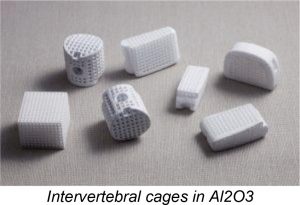
- Bones substitutes: 3DCERAM has developed a stereo-lithography technology for the manufacture of custom-made bioceramic cranial or jawbone implants named BioCranium®. The custom hydroxyapatite ceramics implants allow the replacement of the important osseous defects of the dome of the skull and the jawbone part, thus guaranteeing the protection of the subjacent anatomical structures. This custom method is also used in reconstructive surgery for the patients carrying of a loss of cranio-facial osseous substance, after a surgical act. The ceramic implants are an alternative to the osseous grafts which very often come from the patient themselves, and thus avoid them additional pain.
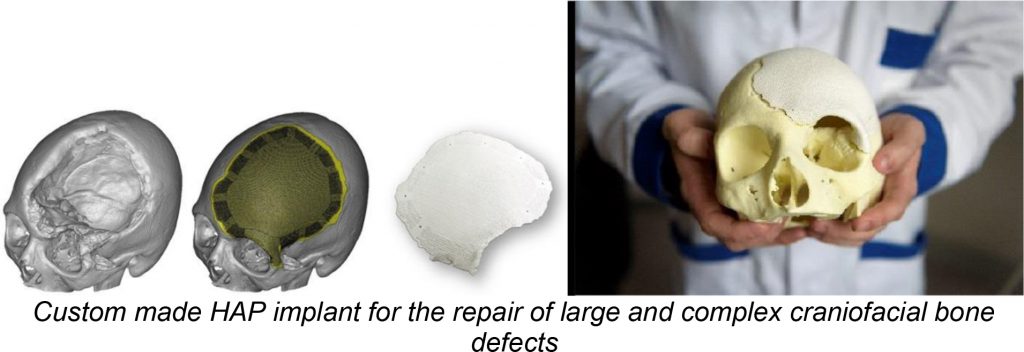
- Surgical tools and instruments: As part of the European project H2020 NEXIS (Next Generation X-ray Imaging System), 3DCERAM has been selected in the consortium for its 3D ceramic printing technologies. The goal of the NEXIS European project is to develop a new spectral detector to improve image quality and features for a quick diagnosis of stroke directly in the intervention room. 3DCERAM will be responsible for manufacturing scintillators by 3D printing for the detector of the system.

- Dental: this sector could potentially become one of the largest through the implementation of 3D printing processes. The ideal mechanical, biocompatibility and aesthetic properties of ceramics, combined with 3D printing for production of complex shapes, could enable ceramics to fully replace polymer and metal implants. The implementation of zirconia 3D printing greatly improve efficiency, saving on materials and costs as well as time.
THE 3D PRINTING PROCESS
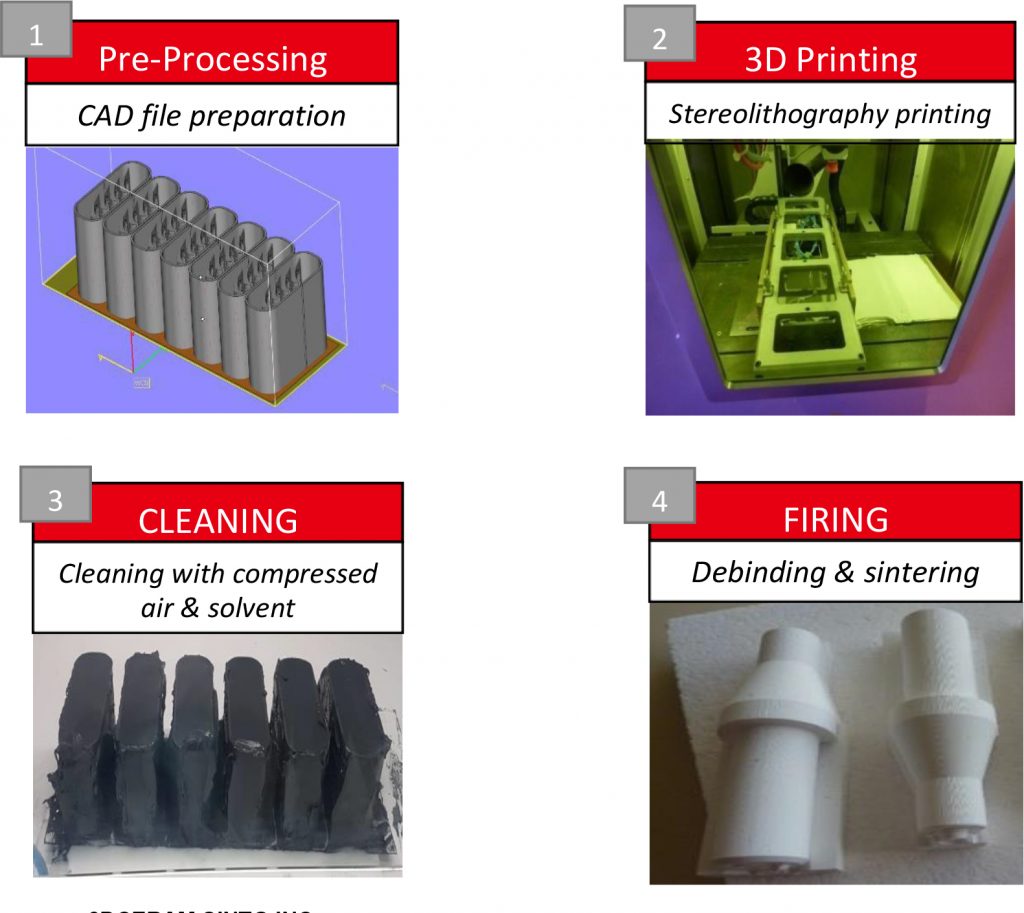
DIVERSITY IN MATERIALS: 3DMIX
Calcium phosphates, such as hydroxyapatite or tricalcium phosphates, are the synthetic materials closest to bone. They are widely known in medical circles for their osteoconductive properties, especially when the macropores size and porosity of interconnection are controlled. In addition they have minimal risk of rejection.
The following ceramics that are mainly used in biomedical sector and proposed by 3DCERAM:
- Alumina (AI203) : basic material being useful in medical prostheses: good mechanical behavior, great hardness, good wear resistance, corrosion resistantZirconia (ZrO2) : Useful in surgical instrumentation and odontology prosthesis (crowns and bridges), porous coating dentistry: material with very good mechanical properties, great hardness, good wear resistance, corrosion resistant
- HAP (Hydroxyapatite) : Non resorbable material used in the biomedical applications for the manufacture of the osseous substitutes, chemical composition close to bone, osseointegration (For example, tibial osteotomy wedges, invertebral cag
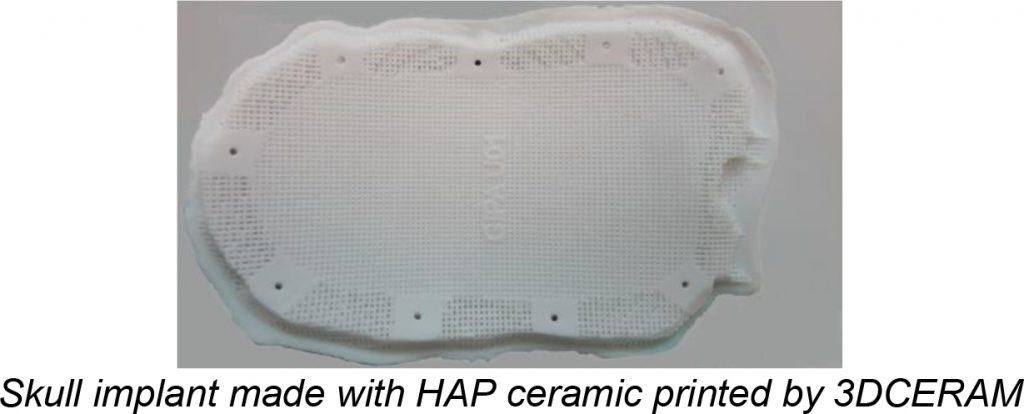
- TCP (Tri Calcium Phosphate) : Resorbable materials in vivo, dental applications
- ATZ (Alumina Toughened Zirconia) : good hardness and resistant to wear. Applications include- orthopaedic prosthetics, teeth
COMPLETE SOLUTIONS FOR CERAMIC AM
With the Ceramaker machine, 3DCERAM offers a custom engineering solution and a complete line for high quality production:
- Turnkey line
- A reliable and proven open 3D printer
- Cleaning station
- Debinding and sintering kilns
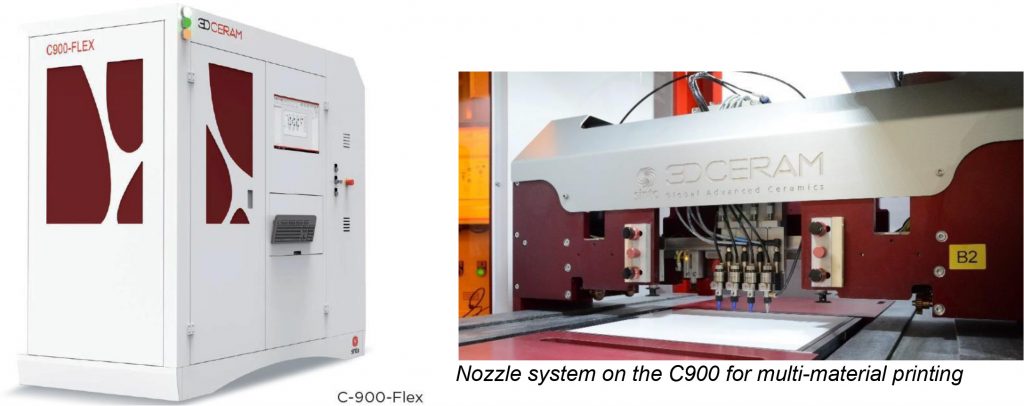
In addition, the future of 3D printing is multiple materials. To answer to this request, 3DCERAM has developed the multi material CERAMAKER® 900H : the only printer on the market able to produce parts by these diverse specifications and the needs of the end user. The innovation is to use stereolithography technology to produce complex multi-material parts of ceramic-ceramic or ceramic-metal or ceramicpolymers.

Albert Tarançon, Senior Scientist of the Cell3Ditor project at L’IREC declares : “the 3D printing technology developed by 3DCERAM via their Hybrid machine revolutionizes the production of ceramics and develop the 3D printing of multimaterials and eventually complete devices”.
SUPPORT TO OBTAIN THE RIGHT CERTIFICATIONS
This industry is highly regulated. One key factor in 3D printing for the biomedical sector is obtaining the certifications to produce parts. 3DCERAM is certified ISO 9001 and ISO 13485 and propose to accompany its customers in getting the right certifications.
CUSTOMIZED TRAININGS
3DCERAM pioneered ceramic additive manufacturing and has built an expertise in biomedical based on more than 15 years of experience. Combining its ceramic and 3D printing expertise, 3DCERAM has designed tailor-made process audit and training sessions to help its customers and give a new dimension to their ceramic projects. 3DCERAM provides expert insight in the domain of 3D printing of ceramics for the development of parts production using the Ceramaker.
3D ceramic printing is a disruptive technology and can have an effect on the traditional business organization channels. Several modules and levels of training are available: from the introduction to the principals of 3D ceramic printing, detailing the important parts of the process, the why, how and when of ceramic printing, while studying real life examples of printing optimization.
3D ceramic printing technology is used to optimize and facilitate the production of complex parts to achieve long term benefits to the final client.
According to a ten-year opportunity analysis paper, produced by Smartech Markets, the future for ceramic additive manufacturing of technical ceramics is bright. There is an encouraging shift from research to full scale production of technical ceramics. 3DCERAM with their new disruptive technology and expertise in biomedical sector are well positioned to lead the way to an exciting future with high aspirations!
ABOUT 3DCERAM-SINTO
Created in 2001, 3DCERAM (www.3Dceram.com) is a company based in Limoges, owned and managed by Christophe Chaput and Richard Gaignon since 2009. In 2018, Sintokogio Ltd. of Nagoya, Japan, acquired 3DCERAM.
In late 2018 the decision was made to expand into the North American market by establishing 3DCERAM Sinto, Inc. in Wallingford, CT, USA. With the Grand Opening in May of 2019, our applications laboratory was opened and provides additional support and services to North American clientele. Peter Durcan, V.P. Sales is the leader for our North American affiliate.
3DCeram regroups un-paralleled expertise in the technology of 3D printing, offering a complete package by accompanying their clients on their chosen projects, choice of ceramic, production specification, R&D, modification of 3D parts just to industrialization, on demand production, the selling of the CERMAKER® 900 printers and the associated consumables.
DOWNLOAD FULL PAPER HERE
Want to know more about 3DCeram Sinto USA’s 3D Technology?
